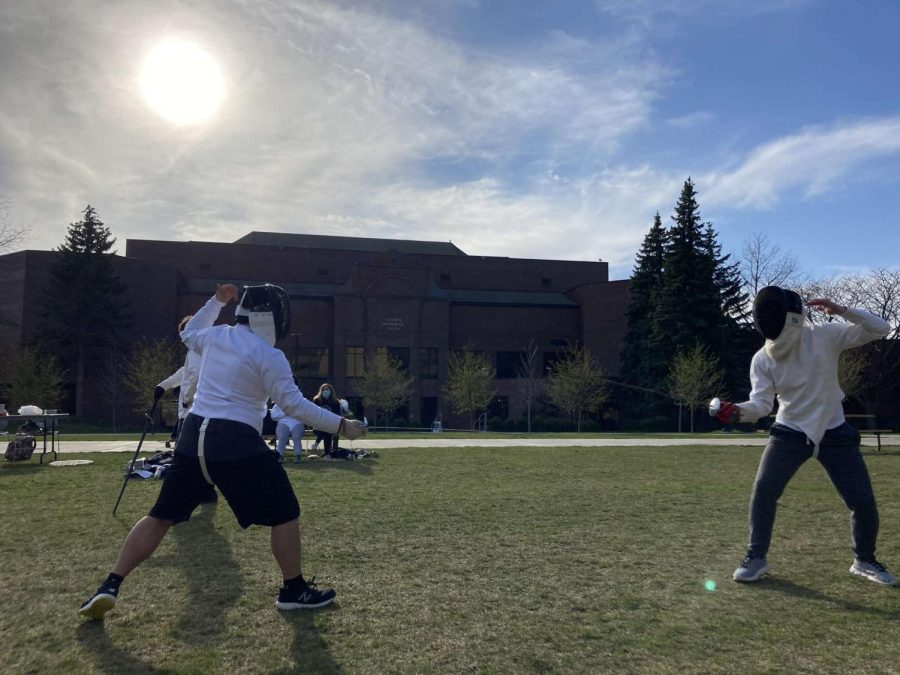“The pen is mightier than the sword,” Shakespeare wrote in “Hamlet”. However, for the Marquette Fencing Club swords are mightier than pens when preparing to foil its opponents.
Fencing began in Italy and Germany as a form of military training before it became a sport centuries ago. The sport features three different types of swords that can be used: the épée, foil or saber for attack and defense.
Eric Nassos, a junior in the College of Business Administration and the president of the Fencing Club, said the club is an Italian-style fencing club “with a maestro or master teaching the sport.”
“Our club teaches the classical aspects and the techniques of Italian fencing so we don’t wear knight’s armor like many people think. We wanted to get back to the core basics of what fencing is and not necessarily focusing so much on the little point touches,” Nassos said.
Nassos said the club focuses on the dueling principles.
“We also put emphasis on the martial arts aspects of old school fencing and then apply it to the modern sport,” Nassos said.
Ethan Evers, a first year in the College of Arts & Sciences, said mental toughness is equally as important as the physical aspect needed to compete in fencing.
“It’s like chess on your feet,” Evers said. “There’s always going to be that physical aspect, but if you’re more technically experienced or you have a little bit more of that ability to strategize, you can still completely blow away someone who is bigger or faster.”
Amaya Ibanez-Baldor, a junior in the College of Engineering, said there is a link between the mental aspect of fencing and school academics.
“Fencing has changed the whole way I look at the sport and look at school now, too,” Ibanez-Baldor said. “I am thinking more analytically now that I am learning how to fence and the strategy that accompanies it.”
Evers emphaizes the importance of understanding the challenges of the mind-body connection.
“I feel like you always have to be on the move in your brain as well as your feet. And if a move doesn’t work, you need to switch in your mind and accept your mistake and change your strategy,” Evers said.
Mary Oates, a first-year in the College of Arts & Sciences, said each member has to wear special equipment to protect themselves from the sword.
“You have the protective gear that you have to wear like your helmet and you wear a jacket. That has some padding on it to protect your chest,” Oates said.
The objective of fencing is to score a point or touch by hitting your opponent’s target with your sword before they get the scoring touch on you, but the rules, strategies and target areas differ with each weapon to make the games distinct, Nassos explained.
Nassos said the team uses the foil, as it is the easiest sword to work with and learn scoring techniques.
“With each type of sword there are different target areas to touch and all have different values for who gets a point,” Nassos said. “At our club, we don’t have electric scoring and we have four people watching to score the points. A bout at our club is between three to five points.”
Nassos added that there are a variety of approaches to attack the opponent’s body.
“Most people target the chest but you can touch the neck, thigh and arm with stabbing or slashing moves, but fencing is much more sophisticated in touches and movements to score points.” Nassos said.
Evers stated the impact of the sword during a match.
“If you get touched it can be a bit painful, but there is a real adrenaline rush when you are fencing and touching your opponent,” Evers said.
Ibanez-Baldor said there is a stereotype of fencing, like the one seen in movies, when it comes to sword fighting.
“This is not a sport where you’re stabbing people or getting stabbed. It’s really mental for me personally because you think in the moment and step ahead to defend yourself from getting touched and be in a position to touch your opponent,” Ibanez-Baldor said.
The team formed in 2000 and currently has 22 members. The club practices three times a week at Humphrey Hall. Oates said their time spent together is getting to know each other as much as learning techniques for fencing.
“My favorite part about fencing is learning the history of the sport and getting to know a diverse group of people in the club,” Oates said.
This spring, there will be an intramural tournament Saturday, April 23where members of the team will put on an exhibition for students to watch and learn about fencing at Marquette.
“I want to make sure the Fencing Club, which is an ancient art, continues on campus,” Nassos said.
This story was written by Catherine Fink. She can be reached at [email protected]


Charles Pierce J-75 • Mar 29, 2022 at 2:43 pm
As the last captain of the previous MU fencing club, I say huzzah.